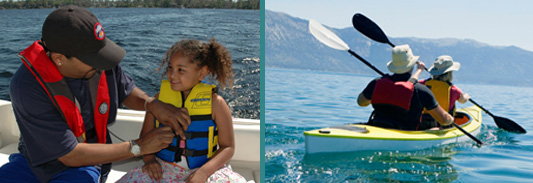Boating Safety

National Safe Boating Week: May 17-23, 2008
More than 70,000,000 Americans enjoy recreational boating each year. Annual boat registrations have increased steadily from just over 10 million in 1988 to 12.7 million in 2006. During this same time period, boating-related fatalities have decreased, due in part to increased use of life jackets, or personal flotation devices (PFD).
May 17-23, 2008 is National Safe Boating Week. The theme for this year’s North American Safe Boating Campaign is "Wear it!” and focuses on promoting life jacket use.
In 2006 3,474 persons were reported injured and 710 died in boating incidents. Among those who drowned, 9 out of ten were not wearing life jackets. The North American Safe Boating Campaign wants to raise awareness and ensure that every person on a boat is wearing a life jacket.
Information about the North American Safe Boating Campaign and event planning materials are available from the campaign website. *
Source: U.S. Coast Guard, Department of Homeland Security (US). Boating Statistics – 2006 [online]. 2008. [cited 2008 March 26]. Available from URL: http://www.uscgboating.org/statistics/Boating_Statistics_2006.pdf
Quick Facts
- In 2006, the U.S. Coast Guard received reports for 4,967 boating incidents; 3,474 participants were reported injured and 710 died in boating incidents.
- Overall, 70% of fatal boating accident victims drowned in 2006—about a 15% decline from the 82% of victims who died from drowning in 1990. The remaining boating fatalities were due to trauma, hypothermia, carbon monoxide poisoning, or other causes.
- It is estimated that 423 lives could have been saved in 2006 if all boaters had worn life jackets.
- Alcohol involvement was the leading contributing factor in fatal boating accidents, contributing to about one in five reported boating deaths.
- Open motor boats were involved in 45% of all reported incidents and personal watercraft were involved in another 24%.
- There was an increase in 2006 in the number of reported fatalities associated with the use of canoes/kayaks. The number of deaths associated with these types of crafts increased from 78 in 2005 to 99 in 2006.
Source: U.S. Coast Guard, Department of Homeland Security (US). Boating Statistics – 2006 [online]. 2008. [cited 2008 March 26]. Available from URL: http://www.uscgboating.org/statistics/Boating_Statistics_2006.pdf.
Tips for Preventing Boat Injuries and Deaths
Wear Your Life Jacket While Boating
Life jacket use by all boat occupants can reduce drownings. Coast Guard-approved life jackets are now more attractive in appearance and comfortable to wear. When properly fitted, a life jacket or PFD can help to prevent a tragedy.
Avoid Alcoholic Beverages While Boating
Alcohol use affects judgment, vision, balance, and coordination. Reports suggest that alcohol was a contributing factor in about one in five boating fatalities.
Complete a Boating Education Course
Most reported incidents in 2006 involved operator-controllable factors. The primary causes of incidents were carelessness or recklessness, operator inattention, operator inexperience, and unsafe speeds.
Boating education courses teach the regulatory and statutory rules (“Rules of the Road”) for the safe operation and navigation of recreational boats. In 2006, 70% of all boating fatalities occurred on boats where the boat operator had not attended a boating safety education course.
Participate in the Vessel Safety Check (VSC) Program
The Vessel Safety Check (VSC) is a free public service provided by the U.S. Coast Guard Auxiliary and U.S. Power Squadron volunteer organizations promoting boating safety. These volunteer personnel check safety equipment and provide information about equipment purpose, safety procedures and applicable regulations. For more information on the VSC Program, visit their web site: www.vesselsafetycheck.org. *
Be Aware of the Risk of Carbon Monoxide (CO) Poisoning
All internal combustion engines emit CO, an odorless, colorless, poisonous gas. In the early stages, the symptoms of CO poisoning are similar to seasickness and CO can kill in a matter of minutes. There is potential for CO poisoning during the use of air conditioning powered by an onboard motor generator; the operation of any gasoline-powered engine while docked and/or rafted with other boats operating engines; swimming or floating near an idling boat engine; or running your boat, or being underway with improper cabin ventilation. To avoid CO poisoning, be aware of the risk, ensure sufficient ventilation, properly install and maintain equipment, and use CO detectors, especially in living and sleeping areas.
Be sure to check state and local requirements, available from the National Association of State Boating Law Administrators website, before boating. There are different rules and regulations for operator-age, safety equipment, etc. in different parts of the country.
Source: U.S. Coast Guard, Department of Homeland Security (US). Boating Statistics – 2006 [online]. 2008. [cited 2008 March 26]. Available from URL: http://www.uscgboating.org/statistics/Boating_Statistics_2006.pdf
Contact Us:
- Centers for Disease Control and Prevention
National Center for Injury Prevention and Control (NCIPC)
4770 Buford Hwy, NE
MS F-63
Atlanta, GA 30341-3717 - 800-CDC-INFO
(800-232-4636)
TTY: (888) 232-6348
24 Hours/Every Day - cdcinfo@cdc.gov

